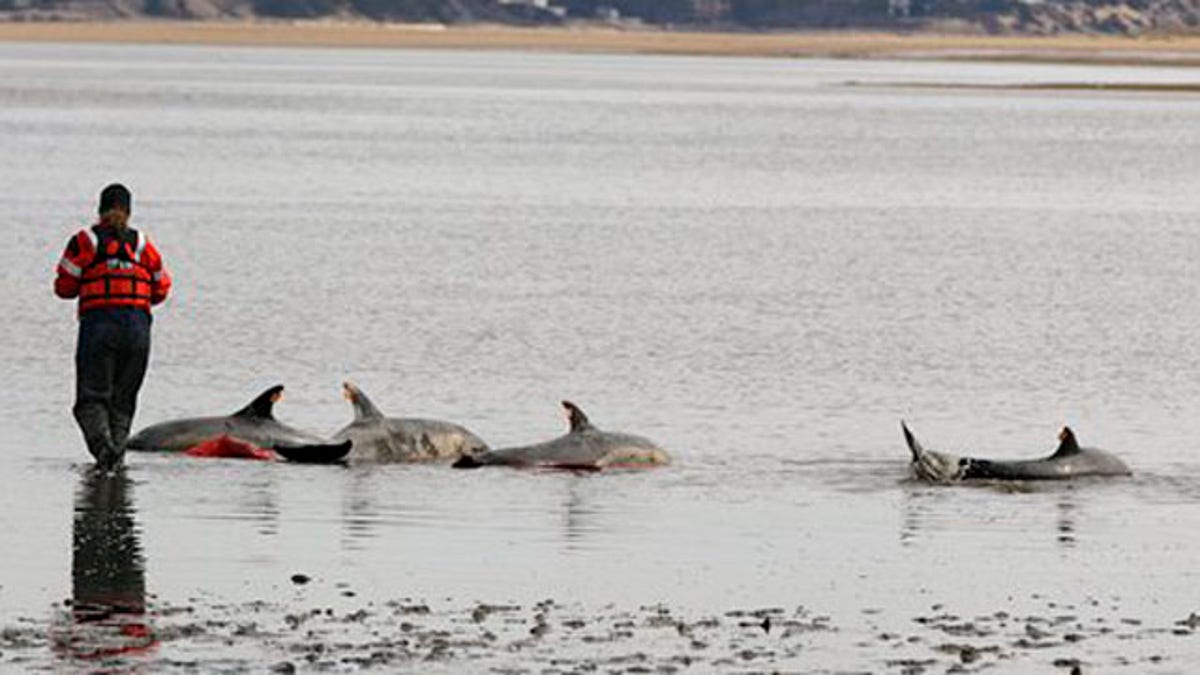
Feb. 14, 2012: Katie Moore, an International Fund for Animal Welfare rescue team member, approaches a portion of a pod of 11 dolphins stranded on a mud flat during low tide in Wellfleet, Mass. (AP)
WELLFLEET, Massachusetts – There's no good spot on Cape Cod for dolphins to continue this winter's massive and unexplained beachings, but a group of 11 has chosen one of the worst.
The remote inlet is a place where the tides recede fast and far, and that's left the animals mired in a grayish-brown mud.
Walking is the only way to reach the animals, but it's not easy. The muck that releases a footstep only after a sucking pop. One rescue volunteer hits a thigh-deep "hole" and tumbles.
One dolphin is dead, but the other 10 appear healthy, and some thump their tails in the shallows, struggling to move. Rescuers decide the best course is to wait for the incoming tide to free the dolphins, then boats can try to herd them out of trouble. The only alternative is hauling them to a waiting trailer, and open water. But the trailer is nearly a mile away.
Waiting has risks. Dolphins can't survive long on land, and there's no guarantee the boats can push the dolphins on to safety.
"Now's where we start crossing our fingers," said Brian Sharp of the International Fund for Animal Welfare.
A year ago, Tuesday's 11 stranded dolphins would have seemed remarkable.
But in the last month, 177 short-beaked common dolphins have stranded on Cape Cod, and 124 have died.
So far, there's no explanation.
Workers at the IFAW, which has led the rescue efforts, tag and take blood samples of the stranded animals, necropsies have been done on dead dolphins and a Congressional briefing was held early this month in the push for answers. But researchers can offer only theories about things such as changes in weather, water temperature or behavior of the dolphins' prey.
Geography may also play a role, if the dolphins are getting lost along the Cape's jagged inner coastline.
Rescuers work in pairs to move the dolphins on slings, bringing them closer together and pointing the right way.
"We'll take advantage of the fact that they're social animals," said Kerry Branon, an IFAW spokeswoman. "We're hoping if we release them together, they'll stick together."
Not all the dolphins are on board, though. One drifts off to the left, where he could beach again.
The manager of the stranding team, Katie Moore, slides over, grabs its dorsal fin, and gives it a push in the right direction.
"You're going the wrong way, buddy," she says.
The inlet continues to fill and the dolphins break into waters that are deeper than the rescuers can follow on foot. They take boats. The noise from the motors pushes the dolphins ahead. So do acoustic pingers, devices that make a sound that annoys the dolphins.
From here, all the shore workers can do is await word from the boats, which will follow the dolphins until dark, if needed.
Volunteer Mike Giblin, muck still on his face, sits in his truck and explains why, at 64, he can't wait to get an early morning call to help the dolphins. The animals are special, he says.
Moore later smiles at the thought, but dismisses any mystical link with the animals.
"They're wild animals," she says. "This is not comforting for them. They don't want to be touched."
She's been encouraged by IFAW's success so far in getting dolphins back to sea. She also believes in the work.
"I think that as humans we have such a huge impact on the ocean environment and on these animals in other ways, that this is our opportunity to do the right thing."
The dolphins would all eventually reach the bay.
